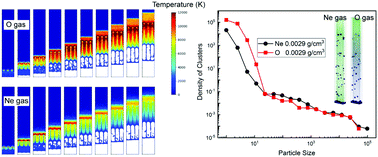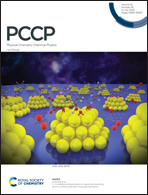Shock-induced ejecta transport and breakup in reactive gas†
Abstract
The transport process of micro-ejecta in reactive gases has recently attracted research attention and interest. Here, we investigate the interaction between shock-induced ejecta of Al and oxygen using a reactive molecular dynamics simulation. The results reveal that metal fragments ejected into reactive gases will quickly increase the temperature of the mixing zone, followed by the deceleration of spikes and a greater shock intensity in the compressed gases, compared with the ejection in inert gases. Moreover, we find that, in vacuum, only a small number of atoms fall out when spherical ejecta particles are finally formed. In the presence of inert gases, several small particles break away from the initial fragments during the transformation of the initially formed strip-shaped fragments into spherical particles, accompanying the detachment of a large number of atoms. When ejecta are transported in reactive gases, the chemical interactions cause more atoms to separate from particles, thus forming smaller fragments and more atomic particles. The research findings show that chemical reactions play an important role in ejecta transport and breakup, which should be considered in future ejecta-transport models for better predictions.



 Please wait while we load your content...
Please wait while we load your content...